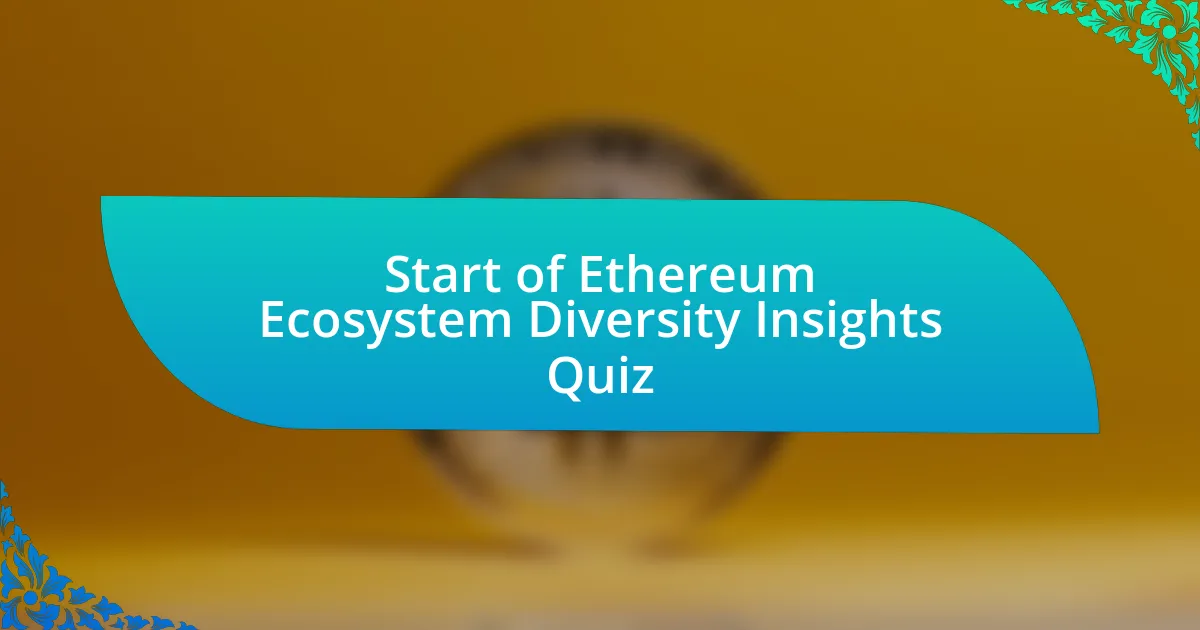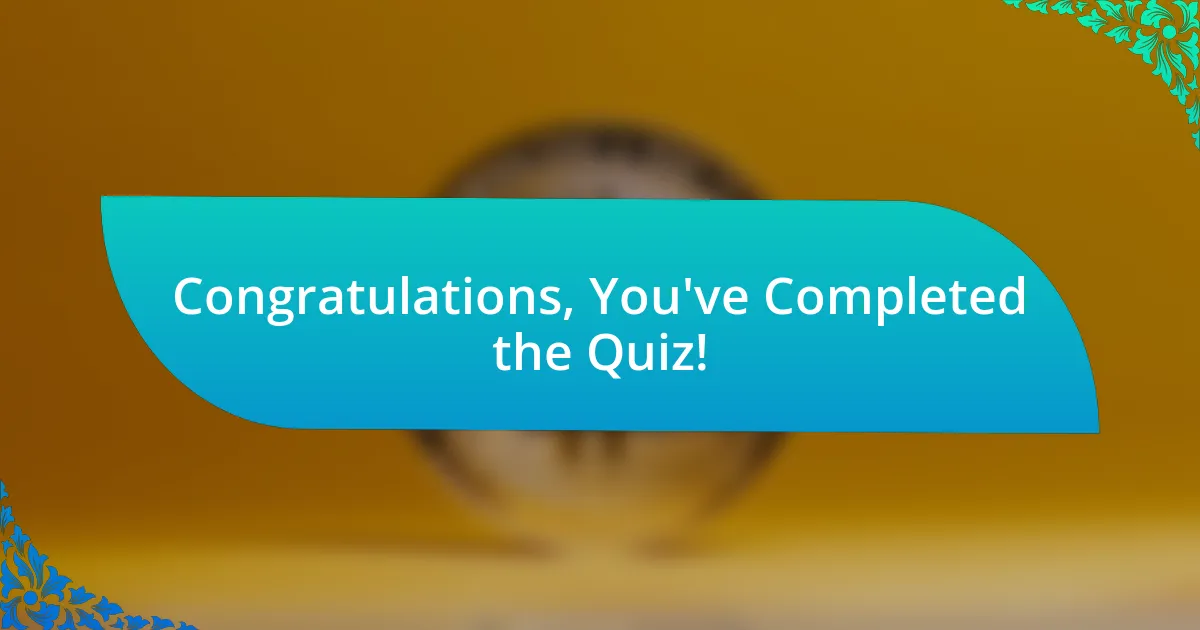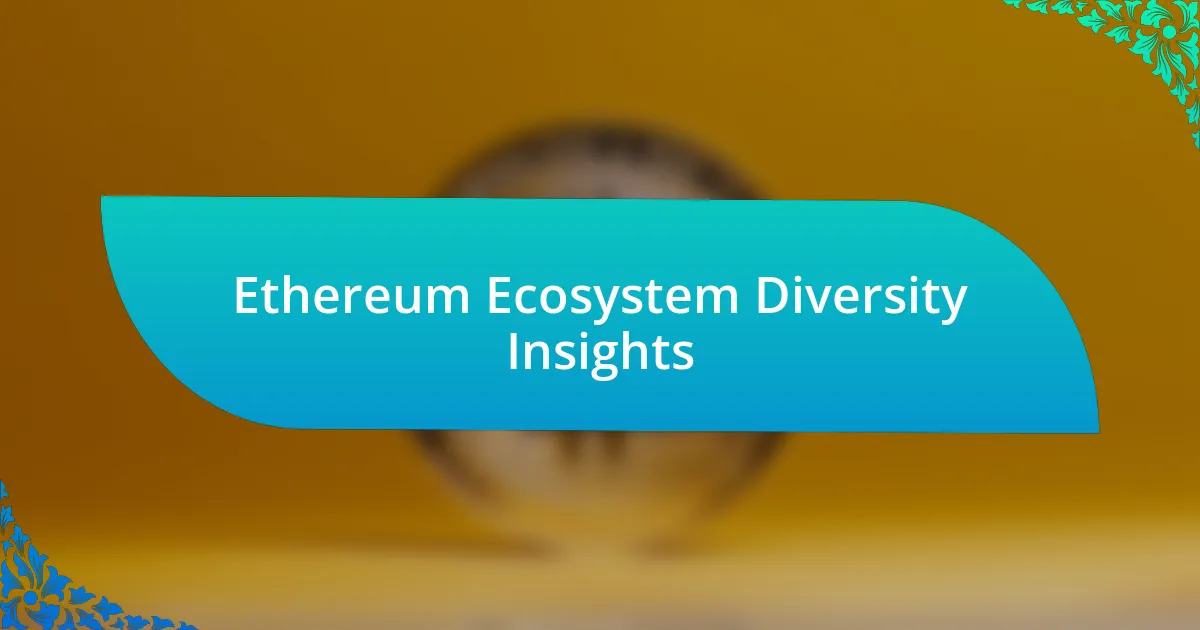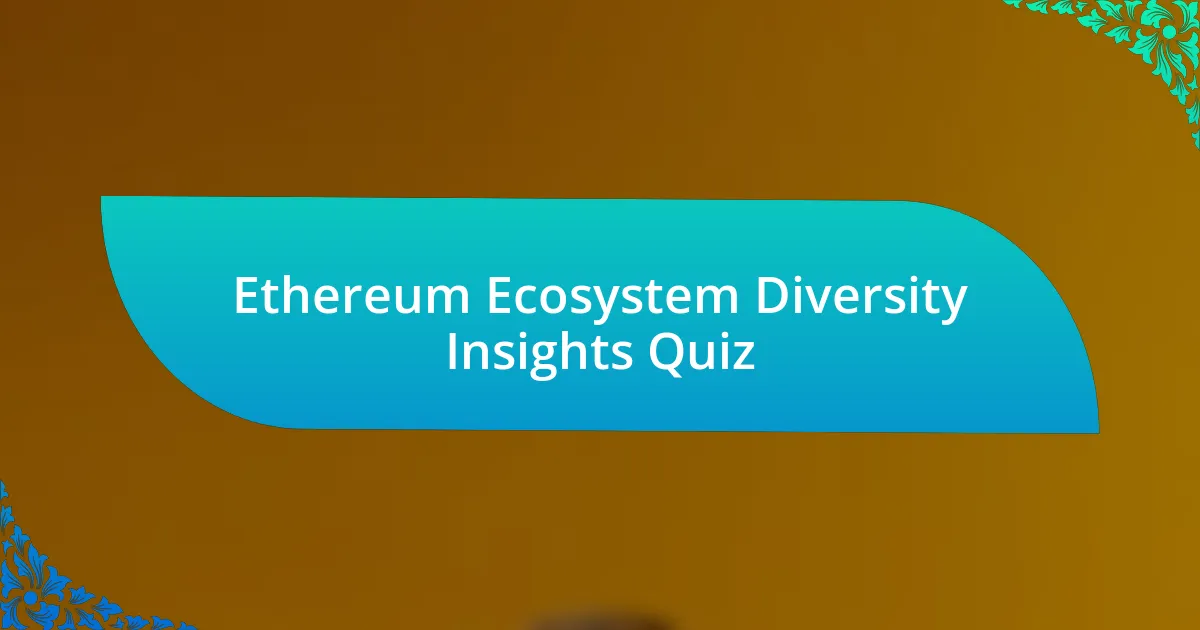
Start of Ethereum Ecosystem Diversity Insights Quiz
1. What is the concept of `cultural extensions` in the Ethereum ecosystem?
- Mechanisms for enforcing compliance with international blockchain regulations within the Ethereum community.
- Financial tools that provide liquidity for Ethereum traders and investors in the market.
- A method of integrating traditional cultural artifacts into the Ethereum blockchain for preservation.
- Layer 2 solutions that enhance cultural diversity within the Ethereum ecosystem by offering a distinct platform for subcultures to engage in meaningful action.
2. Who explores the concept of Layer 2 solutions as cultural extensions of the Ethereum ecosystem?
- Charles Hoskinson
- Gavin Wood
- Joseph Lubin
- Vitalik Buterin
3. What are some subcultures identified within the Ethereum ecosystem?
- Social media marketers, web developers, and NFT artists.
- Gamers, vloggers, and internet influencers.
- Digital nomads, pixel artists, and crypto traders.
- Cypherpunks, regens, and degens.
4. What are the primary values of the core development culture of Layer 1?
- Profit maximization, minimal oversight, conventional practices, and standardization.
- Rapid development, strict hierarchies, competitive exclusivity, and closed sources.
- High-quality thinking, freedom, independence, and cypherpunk ideals.
- Uniform regulation, central control, consensus efficiency, and limited access.
5. Why is cultural pluralism important in the Ethereum ecosystem?
- To streamline decision-making by minimizing cultural differences.
- To ensure all users share the same cultural values and practices.
- To limit the impact of smaller cultures on mainstream development.
- To allow one subculture to focus on core development while another focuses on growing the ‘edges’ of the ecosystem.
6. What role do Layer 2 solutions play in enhancing cultural diversity?
- They centralize all cultural activities in one location, enhancing uniformity.
- They eliminate subcultures to create a single, homogenous community.
- They offer a distinct platform for subcultures to engage in meaningful action, equipped with ample resources and a feedback system that promotes learning and adaptation.
- They restrict resources for specific subcultures to maintain exclusivity.
7. What are some examples of Layer 2 solutions in the Ethereum ecosystem?
- Cardano’s multi-layer architecture and smart contract capabilities.
- Binance Smart Chain’s DeFi ecosystem and yield farming.
- Polygon’s collaborations with mainstream companies, Optimism’s focus on retroactive public goods funding and governance, and Arbitrum’s prioritization of high-quality developer tools.
- Solana’s on-chain governance and staking model.
8. What is the impact of a blockchain being publicly understood as a `casino chain`?
- It becomes hard to get non-casino applications onboard.
- It increases the number of transactions processed.
- It boosts overall adoption of blockchain technology.
- It reduces the risk of security vulnerabilities.
9. What is the significance of client diversity in the Ethereum ecosystem?
- It limits innovation by restricting client options to one predominant choice.
- It creates a single point of failure within the network architecture.
- It centralizes power among only a few development teams.
- It strengthens the network by eliminating the vulnerability of overreliance on any one consensus or execution client.
10. How does client diversity contribute to network resilience?
- It focuses solely on increasing transaction speeds.
- It allows Ethereum to guard against attacks targeting a specific client.
- It makes all clients the same, reducing overall risk.
- It requires all clients to use the same software version.
11. What happened during the 2016 DoS attack targeting Geth clients?
- The attack caused a complete shutdown of the Ethereum network.
- Ethereum weathered the attack without needing to pause the chain by leveraging available alternative clients.
- All Geth clients were permanently disabled following the attack.
- The attack led to the introduction of a new Ethereum protocol version.
12. What is the benefit of having multiple clients spread across multiple teams?
- It limits the creativity of the teams and slows down development.
- It increases the dependency on a single team for all updates.
- It eases pressure on developers and allows for collaboration among different groups.
- It reduces the overall efficiency of the development process.
13. How does client diversity promote growth in the Ethereum ecosystem?
- It expands the number of languages available to potential builders, allowing for a larger ecosystem and more innovation.
- It limits the number of projects that can be developed on Ethereum.
- It increases the risk of centralization among client users.
- It encourages a single standardized client for all developers.
14. What is relay diversity in the context of Ethereum?
- The method of sequentially processing transactions to enhance speed.
- The approach of mixing block builders to reduce transaction costs.
- The strategy of using only one type of relay for efficiency.
- The idea that validators should connect to multiple MEV relays for network resilience.
15. What is MEV-Boost in the Ethereum network?
- A tool for tracking historical transaction data on the Ethereum blockchain.
- A framework for ensuring all transactions are public and accessible to everyone.
- A method for maximizing transaction fees during network congestion.
- The implementation of proto-PBS (Proposer/Builder Separation) on the Ethereum network, allowing validators to communicate with block builders.
16. What is the purpose of the Ethereum Follow Protocol (EFP)?
- To facilitate fast transactional processing for Ethereum-based applications.
- To create a marketplace for digital art transactions among users on Ethereum.
- To provide an on-chain social graph protocol for Ethereum accounts, addressing user experience challenges in decentralized social interaction.
- To develop a new currency specifically for Ethereum network users.
17. What is the key component of EFP at the technical level?
- The underlying Ethereum standard being used to develop EFP.
- The marketing strategy for EFP adoption.
- The transaction speed limits set for EFP.
- The consensus algorithm implemented by EFP.
18. Why is decentralized social interaction critical in Web3?
- It centralizes data management and control.
- It promotes reliance on a single point of authority.
- It limits user interaction and participation in the platform.
- It enhances user experience and fosters community engagement.
19. What is the long-term roadmap of EFP?
- Limiting features to core developers only.
- Focusing solely on Layer 1 enhancements.
- Integrating with other projects and expanding its user base.
- Restricting user engagement to existing clients.
20. How does EFP address user experience challenges?
- By providing a seamless and intuitive interface for social interactions on the blockchain.
- By limiting the number of interactions to improve security.
- By requiring complex procedures for user engagement.
- By focusing solely on financial transactions for users.
21. What are the performance effects of client diversity in the Ethereum ecosystem?
- It contributes to a better understanding and stability of the entire Ethereum ecosystem by mitigating second-level effects for validator behavior and diverse participation.
- It has no significant impact on the performance or security of the Ethereum network.
- It reduces the overall number of available clients and leads to centralization.
- It limits the diversity of developers and prevents innovation in client software.
22. Which two CL clients are analyzed for their performance effects in the context of client diversity?
- Geth and Besu
- Lighthouse and Teku
- Pantheon and Solana
- Erigon and Nimbus
23. What is the significance of having different clients in the Ethereum protocol?
- It fosters innovation by allowing different teams to propose and implement changes to the Ethereum protocol.
- It limits the functionality of the network to simplify user experience.
- It reduces the number of developers required for project completion.
- It centralizes the control of the Ethereum protocol within a single organization.
24. What happens if the majority does not exceed the 67% threshold in case of a critical bug?
- The system will automatically switch to a backup client.
- A bug in a single client cannot be finalized.
- The network shuts down until an update is released.
- All clients will be forced to freeze transactions.
25. What is the role of on-chain incentives in encouraging diversity among client deployments and infrastructure?
- They limit the number of clients to ensure uniformity in infrastructure.
- They create a competitive environment that discourages collaboration among clients.
- They strongly encourage diversity among client deployments and infrastructure by providing incentives and penalties.
- They allow only a few dominant clients to set the network standards.
26. What is the impact of overreliance on a single type of client software?
- It leads to faster transaction processing and validation.
- It enhances user experience by simplifying software use.
- It increases the risk of a single point of failure in case of a critical bug.
- It guarantees improved performance across all clients.
27. What is the purpose of MEV relays in the Ethereum network?
- To implement smart contracts directly on the Ethereum blockchain without any intermediaries.
- To create a single point of contact for all Ethereum development activities.
- To validate transactions more efficiently and reduce network fees.
- To allow validators to communicate with block builders and ensure the network is not overly reliant on a single team or piece of infrastructure.
28. What is the significance of geographical, organizational, and software development decentralization in the Ethereum network?
- It centralizes control over blockchain transactions and network operations.
- It contributes to the dynamic liveness of the network and allows for its self-healing properties.
- It increases the reliance on a single client solution for managing resources.
- It restricts the development of new features and updates to the network.
29. What is the benefit of having a diverse set of clients in the Ethereum ecosystem?
- It focuses solely on increasing transaction speed without regard to security.
- It ensures all clients have the same features and functions.
- It provides a level of decentralization of block production necessary for dynamic liveness and self-healing properties.
- It limits network growth by restricting clients to a single organization.
30. What is the role of bug bounty programs in protecting the Ethereum network from attacks?
- They help protect the network from attacks by encouraging open-source, transparent development practices.
- They centralize software development under one organization for efficiency.
- They focus solely on finding bugs in proprietary software.
- They enforce strict rules that limit collaboration among developers.

Congratulations, You’ve Completed the Quiz!
Well done on finishing the quiz on ‘Ethereum Ecosystem Diversity Insights.’ We hope you enjoyed the challenge and found it both engaging and informative. It is essential to understand the complexities and nuances within the Ethereum ecosystem, which is diverse and constantly evolving. Through this quiz, you likely gained insights into various projects, technologies, and the community that fuels this dynamic platform.
Throughout this experience, you may have learned about Ethereum’s role in decentralized finance, smart contracts, and how different layers of its ecosystem integrate to provide innovative solutions. Each question was designed to deepen your understanding of these concepts. This knowledge is invaluable as you navigate the world of blockchain technology and its implications for the future.
We invite you to expand your understanding even further by exploring the next section on this page dedicated to ‘Ethereum Ecosystem Diversity Insights.’ Here, you will find detailed information that complements what you learned in the quiz. Enhance your knowledge and stay updated on trends and developments within the Ethereum community. Your journey into the world of Ethereum continues here!

Ethereum Ecosystem Diversity Insights
Understanding the Ethereum Ecosystem
The Ethereum ecosystem refers to the decentralized network built on the Ethereum blockchain. It includes various components such as smart contracts, decentralized applications (dApps), and protocols. This ecosystem facilitates peer-to-peer transactions without intermediaries, enabling diverse use cases. Blockchain technology underpins Ethereum, ensuring transparency and security. The ecosystem attracts developers and users, fostering innovation and collaboration across industries.
Diversity of Decentralized Applications (dApps)
Decentralized applications (dApps) are a crucial part of the Ethereum ecosystem. They leverage smart contracts to operate autonomously on the blockchain. The dApps cover various sectors, including finance (DeFi), gaming, and supply chain management. This diversity allows users to access a wide range of services. Each dApp contributes uniquely to the ecosystem, driving engagement and adoption.
Role of Decentralized Finance (DeFi) in Ethereum
Decentralized Finance (DeFi) represents a significant segment within the Ethereum ecosystem. DeFi platforms enable financial services like lending, borrowing, and trading without traditional banks. They utilize smart contracts for automated execution of transactions. This innovation provides users with greater control over their assets and reduces reliance on centralized entities. The rapid growth of DeFi demonstrates Ethereum’s versatility and potential for financial inclusion.
NFTs and Their Impact on the Ethereum Ecosystem
Non-fungible tokens (NFTs) have emerged as a vital element of the Ethereum ecosystem. NFTs represent unique digital assets verified through blockchain technology. They have transformed sectors such as art, music, and gaming by providing ownership and authenticity. The NFT marketplace thrives on Ethereum, showcasing its capabilities beyond currency. This expansion enhances the ecosystem’s diversity by attracting artists, creators, and collectors.
Interoperability and Layer-2 Solutions
Interoperability refers to the ability of different blockchains to communicate and exchange information. Layer-2 solutions, like Optimism and Polygon, enhance Ethereum’s scalability and transaction speed. These solutions allow for seamless interactions between Ethereum and other blockchain networks. They address congestion issues, making the ecosystem more efficient. Such enhancements support a broader range of applications and user experiences.
What is the Ethereum Ecosystem Diversity?
The Ethereum Ecosystem Diversity refers to the range of applications, platforms, and communities that operate on the Ethereum network. This includes decentralized finance (DeFi) platforms, non-fungible tokens (NFTs), decentralized applications (dApps), and various developer tools. As of 2023, Ethereum hosts over 3,000 active dApps, illustrating its diverse ecosystem and widespread adoption.
How has the Ethereum Ecosystem evolved?
The Ethereum Ecosystem has evolved through several key upgrades and the introduction of layer-2 solutions to enhance scalability and efficiency. The network transitioned from Proof of Work to Proof of Stake in 2022, known as “The Merge.” This upgrade improved energy efficiency by over 99%, allowing for more transactions per second and fostering innovation within the ecosystem.
Where can one access Ethereum-based applications?
Ethereum-based applications can be accessed primarily through decentralized finance platforms, online wallets, and blockchain explorers. Major platforms like Uniswap and OpenSea are accessible via standard web browsers. Additionally, many dApps can be interacted with through popular wallets such as MetaMask, which facilitates user access to multiple Ethereum services in one place.
When was Ethereum first launched?
Ethereum was first launched on July 30, 2015. This initial release introduced smart contract functionality, enabling programmable transactions on the blockchain. The launch established the foundation for a multitude of decentralized applications and set the stage for Ethereum’s growth into a leading blockchain platform.
Who are the key contributors to the Ethereum Ecosystem?
Key contributors to the Ethereum Ecosystem include the Ethereum Foundation, a non-profit organization supporting the development of Ethereum, and numerous developers globally. Vitalik Buterin, one of Ethereum’s co-founders, remains a prominent figure, while teams behind projects like ConsenSys and various DeFi protocols also play crucial roles in the ecosystem’s growth and innovation.

